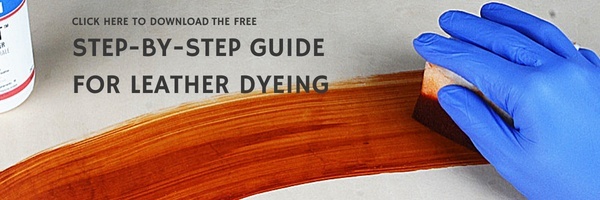How can you get the desired leather dye color on my leather item? You can always get what you want, but keep in mind that you can not get any color on any type of leather. You must know the differences among leather dyes for leather crafter, then choose and the right leather and the appropriate leather dye
Before going into many details we have to make a consideration: leather dyes, whether alcohol based or water based, have the main feature of being semi-transparent and non-coating. This because in their formula anilines are used as coloring substances.
Anilines (unlike pigments) used in leather dye colors are transparent dyes, so the final color will be influenced by the base color of the leather on which we apply it
To better clarify this concept, we want to make an example: let's consider having a fuchsia color highlighter: if we apply it on a white paper sheet, the result will be a nice bright pink, but if we apply it on a black paper sheet, the result is different. The leather we have to dye represents our sheet, so its base color will influence the final shade.
In leather goods creation, you generally work with not finished leathers without finishing that are more suitable for the coloring phase. When we have to choose the color for a new leather creation, it is important to take into consideration the material (leather) that we will use. Mainly there are two types of leather: vegetable tanned leather or chrome tanned leather.
When we use vegetable-tanned leather, the leather will have its characteristic natural color, which can be more or less light depending on the tanning process and its duration, the type of tannins used in tanning, etc. This color is usually a light reddish brown, so when we choose the leather dye colors we must consider that the base color will influence the final result.
In case we have chosen dark tones, for our creation, we will not have big problems to get the desired result on a veg-tanned leather, as the final result will be quite similar to the leather dye colors
But if we wanted to dye it in a light yellow, this will be almost impossible, since the influence of the base color is too strong.
Chrome-tanned leather, on the other hand, can also be found with very light base tones, since the wet-blue produced by chrome tanning nevertheless undergoes a minimum finish and coloring before being placed on the market.
We could find chrome-tanned leathers with very clear base tones, that are well suited for the realization of leather items with light colors
An alternative to chrome tanning is aluminum tanning, whose tanning result is also called wet-white, since the leather is white. This type of tanned leather is less widespread and more difficult to find. By using this process it is also possible to have very light leather dye colors.
To sum up, if our processing involves the use of vegetable tanned leather, it will be preferable to choose darker tones for dyeing the leather. If, on the other hand, our priority is to create a light-colored object, it will be necessary to use chrome-tanned or aluminum-tanned leather, on which it will be easier to apply these light colors.



